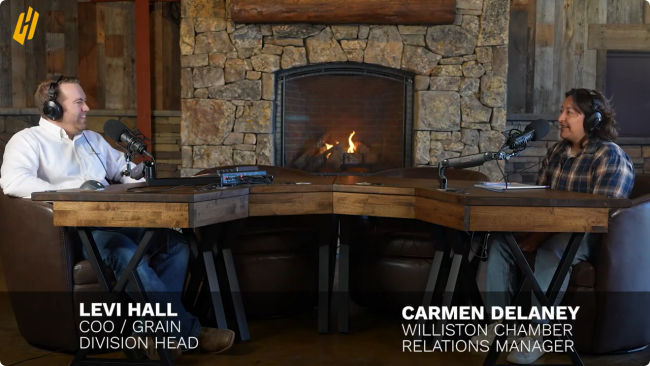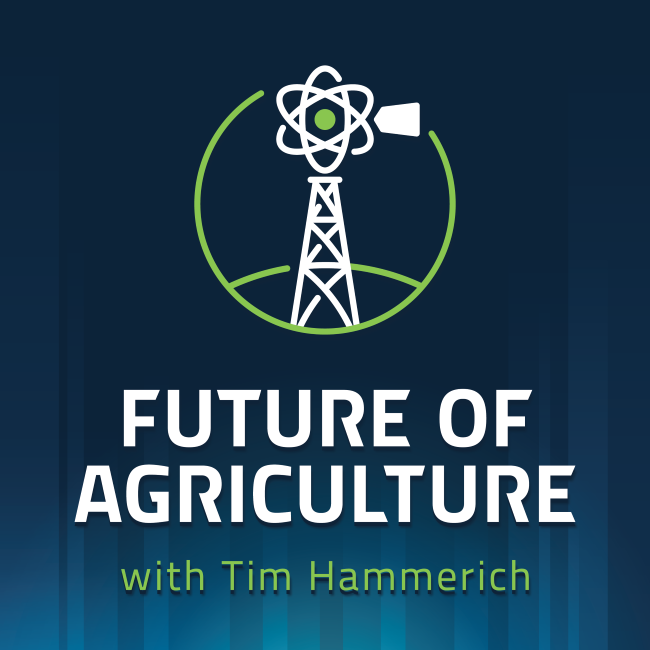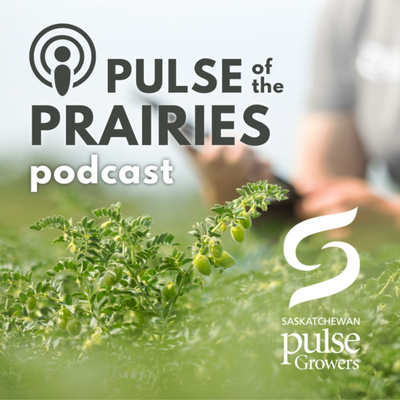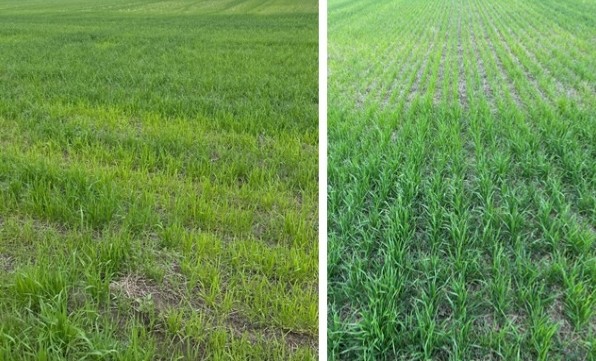Agronomy Update
Oct 17, 2025
On the Horizon Podcast Season 2, Episode 39: Mental Health First Aid with the Williston Chamber of Commerce

In this episode, Levi sits down with Carmen Delaney, Member Relations Manager at the Williston Area Chamber of Commerce, to talk about the upcoming Mental Health First Aid training on October 23rd at TrainND. Carmen shares why the event is so important for the ag and energy sectors, her personal connection to mental health awareness, and how the course equips attendees to recognize signs of struggle and connect others to help. They also discuss the ongoing efforts to break stigma, the real stories behind local initiatives, and how this training builds stronger, more compassionate communities. Listen on Spotify, YouTube or wherever you get your podcasts.
Mental Health First Aid Course at Train ND
Mental Health First Aid (MHFA) teaches you how to identify, understand and respond to signs of mental health and substance use challenges among adults. You will build skills and confidence you need to reach out and provide initial support to those who are struggling. You will also learn how to help connect them to appropriate support.After the course, you will be able to:
- Recognize common signs and symptoms of mental health and substance use challenges
- Understand how to interact with a person in crisis
- Know how to connect a person with help
- Use self-care tools and techniques
Limited to 30 Participants
Member Cost: $50 - Horizon Resources is a WACC member so our member owners will qualify for this discount.
Non-Member Cost: $75 Register HERE
Podcast Listening Season
In the fall our agronomists are spending a lot of time in the soil sample pickup, which for me means catching up on podcast episodes. If you’re not already a podcast listener, I encourage you to give it a try. There is a lot of great information out there, and you don’t have to travel or long onto a zoom call to benefit. Below are some podcast series and episodes that offer valuable, agriculture-focused content.
In the War against Weeds podcast, Dr. Sarah Lancaster (Kansas State University), Dr. Joe Ikley (North Dakota State University), and Dr. Alyssa Essman (The Ohio State University) chat with weed science and agronomy experts to discuss all things weed control.
In Episode 10 of Season 4, Sarah and Joe talk about canola production with Dr. Breanne Tidemann (Agriculture and Agri-Food Canada) and Dr. Mike Cowbrough (Ontario Ministry of Agriculture). They discuss the origins of canola, winter vs spring cultivars, and the challenges associated with growing canola.

The Future of Agriculture explores the people and companies shaping the future of the agriculture industry. Every week, host Tim Hammerich shares conversations with farmers, founders, and thought leaders driving ag innovation. With how important the Chinese market is to the U.S. farm economy, I found the interview with Ian Lahiff fascinating. Originally from Ireland, he has been living and working in China for nearly 14 years. In FoA episode 455, Ian helps us better understand the Chinese market, and even more importantly, unpack some important changes that impact global agriculture. Below is a quote from the episode:
"There's two trends that I think US producers should be concerned about. One is Brazil becoming increasingly close to China, and that Brazilian product can get more easily to the port. And the second is that Chinese producers are actively looking at nutritional solutions where they can reduce the amount of imported soy that they need. The trend looks like US producers need to look for those next markets. I think the boat is sailing on being very reliant on China."

The Agronomists is a weekly podcast from RealAgriculture, a Canadian agriculture news outlet. Our neighbors to the north produce many of the same crops that we do and we can benefit from their experience and expertise. In addition to this podcast, they also
have a radio program, email newsletter and specific crop content like their Canola School. I just started listening to this series, but I really enjoyed their most recent episode on fall weed control featuring Jack Payne of South Country Co-op and Kurtis Pilkington of Bayer CropScience. Episode 209 features Dr. Charles Geddes, a weed scientist who focuses on kochia, and Dr. Peter Sikkema, a weed scientist from Ontario. While we don’t have issues with fleabane in our geography, Peter shares a fascinating story about how fleabane went from being easily controlled with Round Up in 2009 to being the deciding factor in shifting weed management practices among 60% of Ontario growers today. Kochia is clearly going to be our version of fleabane.

Finally, I wanted to share SaskPulse’s Pulse of the Prairies podcast. These episodes come out sporadically, but I like to stay on top of this series as they usually give some good insights into Canadian pulse production, growing conditions and market outlook.
Given the size of the Canadian pulse market, we can expect these trends to impact demand for U.S. pulses.
I’m always interested in finding new agriculture related podcast series, so if you have one you enjoy reach out!
Dr. Audrey Kalil
Agronomist & Outreach Coordinator
Weather Report and Soil Conditions
Soil temperatures have dropped to 50°F and are decreasing (graph below). Once we dry out, it will be the right time to begin making residual herbicide applications for spring. Be sure to consider rotation restrictions for lentils—2 oz of Valor requires a 6-month rotation, while 3 oz requires 7 months. You can delay applications slightly to extend residual control later into the spring, but these products should be applied before the ground freezes.



Fall Fertilizer Application and Winter Fill Program
When people ask us about timing for fall fertilizer, we usually use October 15th as a ballpark estimate to begin applying anhydrous ammonia. We would like to see the soil temperature below 50°F and this is normally the time of year we get to that point. Anhydrous ammonia can be applied earlier than surface-applied urea, as it is injected into the soil and not subject to volatilization and loss into the atmosphere. For surface application of urea, we suggest waiting another 2 weeks beyond the starting point of anhydrous ammonia applications. At this time, the soil temperatures should be in the 40’s so you will have limited soil activity that promotes nitrogen volatilization.
For both urea and anhydrous ammonia we also need to be concerned about leaching. When applied to warmer soils, urea or ammonia will convert to nitrate nitrogen and then be subject to leaching if you have excessive moisture after application. Getting a half inch of rain after an early application will get the nitrogen into the soil and prevent loss due to volatilization, but if the nitrogen was applied to early in the fall then you will have an extended length of time that your nitrogen will still subject to leaching
Surface applications too early in the fall are really easy to pick out in the spring around the time of crop spraying. Fields that have a light green or yellow tint early in the year usually indicate a nitrogen deficit. If urea was surface applied in early September, this could be the answer.

With cereal crops, your yield is determined before jointing, so if you were to notice the yellowing at this point, your yield will already be affected. If you did catch it earlier, you can top dress urea, but you will need rainfall shortly after to move the nitrogen into the soil.
The third way we can lose nitrogen is also associated with excessive moisture in soil, especially any time we have standing water in fields. Nitrogen can be released into the atmosphere by denitrification, and it doesn’t matter if you applied anhydrous ammonia or urea as both are subject to loss by this method. In western North Dakota, excessive moisture is usually not a problem we see, but if you notice difference in crops in spots that you had water standing at one point, this could be the answer why you lacked nutrients in this spot.
Nitrogen is way too expensive to subject it to loss in any way and you definitely do not want to promote losses with poor application timing. Nitrogen markets continue to be high in correlation to commodity prices. We can point our fingers at the grain markets and complain that they need to be higher, and we can do the same with fertilizer prices needing to be lower, but both are absolutely out of our control.
Right now, it is hard to pencil out anything to make money, but this is not the first time we have seen this and it will cycle through and get back to normal. We have seen durum below $5 per bushel followed by durum close to $20 per bushel within a matter of two years and we have seen $1,500 per ton anhydrous ammonia followed by $800 per ton anhydrous within a year. One thing that remains a historical fact with fertilizer is that no matter what the values, at least 80% of the time it will be cheaper to buy it at the end of the year than it is in the spring. Horizon Resources will be offering winter-fill tons to our customers just like we always do.
Depending on contracts available, we usually have tons available at discounted levels for people who want to pay for tons in December and will also have programs available for people who want to sign contracts for spring tons that will be payable in spring. We are also working on a couple of grower finance programs that will extend terms all the way to the end of the year 2026 or into early 2027. If you are interested in our grower finance programs, stop into any of our Agronomy locations and we will fill you in as details become available.
John Salvevold, CCA
Agronomy Division Manager